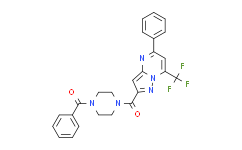Protease activated receptors (PARs) are a family of G-protein-coupled receptors (GPCRs) that are irreversibly activated by proteolytic cleavage of the N terminus, which unmasks a tethered peptide ligand that binds and activates the transmembrane receptor domain, eliciting a cellular cascade in response to inflammatory signals and other stimuli. There are four members of the PAR family: PAR1, PAR2, PAR3 and PAR4. PARs have important functions in the vasculature, inflammation, and cancer and are important drug targets.The PAR family consists of four members: PAR1, PAR2, PAR3, and PAR4. PARs are significant targets for pharmaceuticals and have vital roles in the vasculature, inflammation, and cancer.
With the exception of red blood cells, PARs are expressed on almost all blood and blood vessel wall cell types (ECs, fibroblasts, myocytes), as well as on platelets, neutrophils, macrophages, and leukemic white blood cells. Immune cells, astrocytes, neurons, and epithelium all express thrombin-activated PAR-1, PAR-3, and PAR-4. Human vascular, intestinal, neuronal, and airway cells contain PAR-2, which is activated by serine proteases similar to trypsin. Its expression rises in tissues that have been injured or in response to inflammatory mediator stimulation.
| Structure | Cat No. | Product Name | CAS No. | Product Description |
|---|---|---|---|---|

|
V74499 | 2-Furoyl-LIGRLO-amide | 729589-58-6 | 2-Furoyl-LIGRLO-amide is a potent and specific protease-activated receptor 2 (PAR2) agonist with a pD2 value of 7.0. |

|
V74504 | 2-Furoyl-LIGRLO-amide TFA | 2468029-34-5 | 2-Furoyl-LIGRLO-amide TFA is a potent and specific protease-activated receptor 2 (PAR2) agonist with a pD2 value of 7.0. |

|
V2850 | AC 55541 | 916170-19-9 | AC-55541 is anagonist of protease-activated receptor (PAR) 2. |

|
V71929 | Aeruginosin 98-B | 167228-01-5 | Aeruginosin 98-B is a protease inhibitor. |

|
V74510 | Ala-parafluoroPhe-Arg-Cha-Cit-Tyr-NH2 | 211190-38-4 | Ala-parafluoroPhe-Arg-Cha-Cit-Tyr-NH2 is a biologically active peptide. |

|
V6725 | Atopaxar | 751475-53-3 | Atopaxar, formerly known as E5555, is a potent and orally -active PAR-1 inhibitor. |

|
V74516 | AY254 | 2093408-03-6 | AY254 is an analogue of AY77. |

|
V74515 | AY77 | 1835734-92-3 | AY77 is a calcium-biased PAR2 agonist. |

|
V31712 | AZ3451 | 2100284-59-9 | AZ3451 is a protease-activated receptor-2 (PAR2) antagonist (inhibitor) with IC50 of 23 nM. |

|
V3483 | BMS-986120 | 1478712-37-6 | BMS-986120 (BMS986120) is a novel, potent and orally bioactive antagonist of protease-activated receptor-4 (PAR4) with the potential to be used forthrombus propagation and pathological vascular occlusion. |

|
V51013 | CL-417513 | 313986-65-1 | PAR2 inhibitor |

|
V74514 | FR-171113 | 173904-50-2 | FR171113 is a specific non-peptide thrombin receptor antagonist. |

|
V74501 | FSLLRY-NH2 | 245329-02-6 | FSLLRY-NH2 is a protease-activated receptor 2 (PAR2) inhibitor. |

|
V76998 | FSLLRY-NH2 TFA | FSLLRY-NH2 TFA is a protease-activated receptor 2 (PAR2) inhibitor. | |

|
V76986 | GB-110 hydrochloride | GB-110 HCl is a potent, orally bioactive, non-peptide protease activated receptor 2 (PAR2) agonist. | |

|
V25156 | I-191 | 1690172-25-8 | I-191 is a potent antagonist of protease-activated receptor 2 (PAR2). |

|
V69828 | I-287 | 2014368-93-3 | I-287 is an orally bioactive and selective inhibitor of PAR2 that negatively regulates Gαq and Gα12/13 activities and their downstream effectors. |

|
V2419 | ML161 (Parmodulin 2) | 423735-93-7 | ML-161 is a novel and potent allosteric inhibitor of PAR1 (proteinase-activated receptor 1) on platelets with IC50 of 0.26 μM. |

|
V74512 | P4pal10 | 1021346-05-3 | P4pal10 is a PAR4 antagonist. |

|
V81041 | PAR 4 (1-6) (TFA) (GYPGQV TFA) | PAR 4 (1-6) TFA (GYPGQV TFA) is a hexapeptide that is a fragment of protease-activated receptor 4 (PAR4) and works as a specific inhibitor of PAR4. |